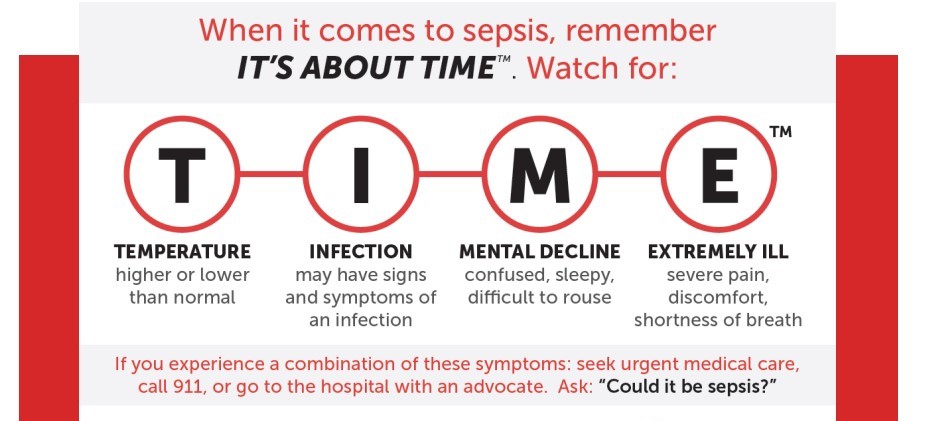September is Sepsis Awareness Month and while it’s been making headlines recently, it makes this month an even more important time to look at why this condition is getting so much attention. Sepsis, which can be a deadly disease, is often misunderstood, and with raised awareness and education, we can help ourselves and others understand its urgency and its opportunities for care. Sepsis is a concerning event that can happen to anyone in and out of the hospital, and the treatment for such a condition is very important for the best outcomes, making this topic timely and the reason learning more can’t wait.
What is sepsis? Chances are you’ve heard about it or seen it in the movies or hospital dramas on primetime TV. However, some people have experienced this illness firsthand. The CDC (www.cdc.gov) shares that the condition can begin in the body as an extreme and dysregulated response to an infection. This infection may begin in the skin, lungs, urinary tract, gut, or anywhere else in the body. Where it starts doesn’t really matter. What matters is when the immune response becomes harmful, triggering widespread inflammation, tissue damage, organ failure, and possibly death. Therefore, any form of sepsis can occur at any time from any infection.
Should you be overly concerned? Yes and no. Many people only see sepsis as a problem that can occur in a hospital setting, when in fact many cases start right in the community. Early detection of this can be delayed because signs are like many other illnesses such as the flu, Covid or the first presenting symptoms, such as fever, chill, confusion, etc. The Vermont Department of Health (VDH) (www.healthyvt.gov) suggests we all take to heart how we are feeling, what feels normal for our bodies and what may feel different from a common infection or illness. If you aren’t often confused when you get the flu or you don’t have an elevated heart rate with a common illness, this is a cause for concern and worth an immediate visit to a healthcare facility.
Many people don’t like to visit the emergency room, walk in urgent care or think they are taking time away from patients who may have other extreme concerns. However, sepsis is an extreme concern. Medical providers are always more than happy to reassure their patients they are free and clear of illness when they can, but when they aren’t, with things like sepsis, time matters! This is a condition where the delay in treatment does increase the risk of death. VDH says that within each hour of delay, mortality can rise substantially, making your trip to the ER very important.
For those who make the visit in a timely manner, there can be some lasting effects. Sepsis takes a toll on the body. Sometimes it can cause organ dysfunction, mobility limitations, mental health effects such as PTSD or cognitive impairment, and amputations in some cases. The CDC shares some survivors often have reduced quality of life due to the traumatic event. However, others will go on to live full lives without any complications.
Not everyone has the same risk of sepsis, yet anyone can get it. This is why awareness matters. Higher risk communities, which are the people who make up most of our community: older adults (65+), people with chronic disease (diabetes, lung disease, cancer, kidney disease), immunocompromised persons, infants, and people recovering in hospitals or nursing homes, should be extra aware. Those who aren’t in these categories should be mindful but aren’t as likely to suffer an incident. What we do know is that being aware and knowing the symptoms saves lives and increases the chances of ongoing effects. Seeking early care and even proper hygiene all help in the battle against sepsis.
Right now, many people are concerned about what they’ve heard in the news. With product recalls with brands like DermaRite, we’ve seen cases show that even everyday skin products can become sources of severe infection if contaminated. Public health and regulatory vigilance remain vital. How did this happen? Easier than one might think! Yes, these products are widely used in healthcare settings; even if no illnesses have yet been reported, the potential risk of bacteria entering open wounds, infecting immuno-compromised people or where hygiene is critical goes to show how minimal contamination can have serious consequences. Maybe it helps us to rethink our own contamination.
Here in Vermont, VDH defines sepsis as , “a medical emergency, caused by abnormal immune reaction to infection, leading to tissue damage, organ failure, death if untreated.” The data (1999‑2005) shares Vermont had age‑adjusted mortality for “infection / septicemia / pneumonia” causes in the ballpark of 47.2 deaths per 100,000 people per year. Another older CDC summary lists Vermont having 264 deaths due to septicemia in one year (2017), with an age‑adjusted mortality of about 30.2 per 100,000. This makes it clear Vermonters aren’t immune to this severe illness.
Sepsis remains a silent threat amongst us. With common infections being part of our normal lives, sometimes the abnormal appearance can escalate quickly. Awareness isn’t just knowing the name “sepsis,” it’s recognizing the risk, knowing the signs, and doing something about it. This month we get to do that together! Take time to learn more, research, ask your healthcare teams, talk to friends. And when in doubt, if you ever think you may have symptoms or worries around sepsis, get help fast. It saves lives! Your life matters and when it comes to sepsis, it can’t wait!


